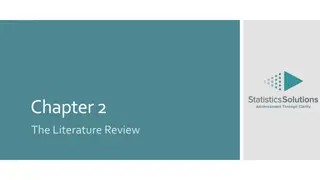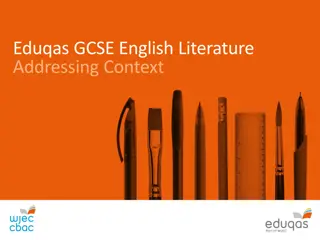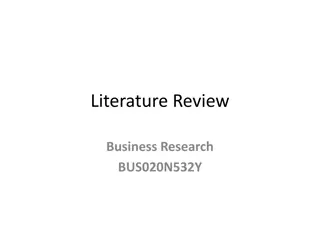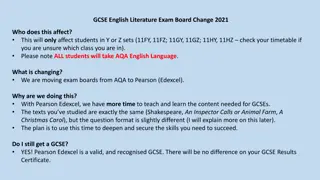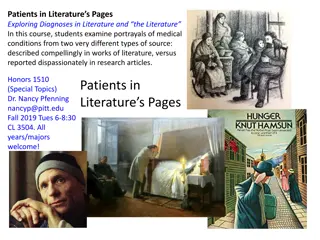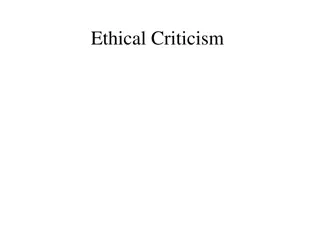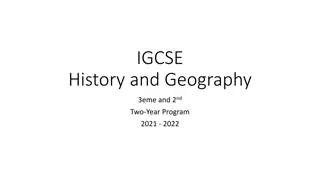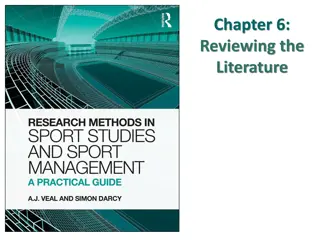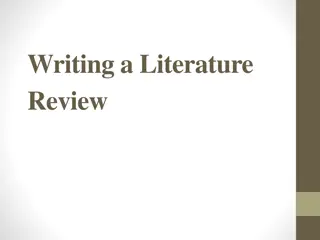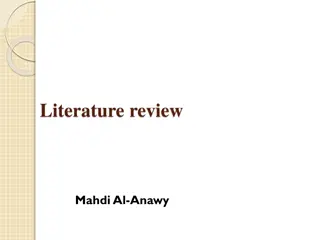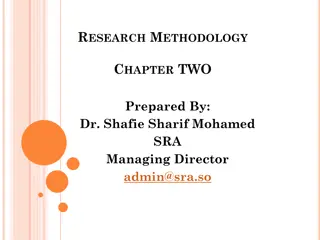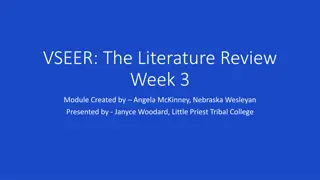Enhancing Students' Understanding of Context in Literature Analysis
Join the Eduqas regional team online session to improve your skills in approaching AO3 context with students. Gain valuable insights on how to write about context effectively, understand the relationships between texts and contexts, and show knowledge in your answers. Discover strategies to build confidence, scaffold writing, and enhance learning methods. Be part of a supportive educational community dedicated to your success in literature analysis.
Download Presentation

Please find below an Image/Link to download the presentation.
The content on the website is provided AS IS for your information and personal use only. It may not be sold, licensed, or shared on other websites without obtaining consent from the author. Download presentation by click this link. If you encounter any issues during the download, it is possible that the publisher has removed the file from their server.
E N D
Presentation Transcript
Welcome to our online meeting #eduqasrepteam
Welcome Thank you for attending the Eduqas regional team online session today.Please remember to turn your audio and video off. If you have questions, please use the Chat function or, if this is not available on your device, email us on hugh.lester@wjec.co.uk. We will answer as many as we can in the second half. Sessions on a variety of qualifications and topics continue until December. Follow the Twitter hashtag #eduqasrepteam to find out more. Eduqas regional team: here to support you Email hugh.lester@wjec.co.uk to be put in touch with the rep for your area.
WJEC Eduqas GCSE English Literature Using contexts effectively
Aims Build confidence with approaches to writing about context with reference to the extract question from 19th Century novel Silas Marner . Use effective learning methods in application. Scaffold writing using a Front the Writing technique.
What do you find most challenging about approaching AO3 (context) with students? Think, Pair, Share
Knowledge of context Writing about context
Knowledge of context Writing about context
What do students have to do to achieve AO3? Show understanding of the relationships between the texts and the contexts in which they were written.
Writing about Context Character Language Themes Plot Character Language Writing about Context Theme Plot Teachers start thinking this but it can also be this
Approaching AO3 Context becomes effective when the student can decide: 1. What is relevant for inclusion in an answer. 2. How best to show their knowledge. 3. How this helps them to appreciate the writing. Be flexible with approaches
Approaching AO3 There are many ways of approaching context within the scope of English Literature: Time and place Language use and meaning Linking themes that are universal and still relevant today Literary period Students often show what they have been taught but not what they know. Developing an understanding of what is relevant to the question is a key idea for the students to develop, guided by the teachers.
Makeit visible Silas Marner She walks in beauty The Prelude Ozymandias 1818 1861 To Autumn Sonnet 43 1814 1850 1820 1844
Linking via themes Love Natural world/M aterial world Loss/Gr ief Silas Marner - themes Childho od/ Age Relations hips Wealth and povert y
Linking via themes Love from a parent to a child as they grow and change. The aging of the parent as the child grows Love Natural world/M aterial world Loss/Gr ief Silas Marner focusses on the relationship s in the small, rural, farming community Silas Marner - themes Childho od/ Age Relations hips Wealth and povert y
Front the Writing Learners engage with a question in a pre writing task everyone must write something. Group discussion facilitates broader knowledge of the question and gives learners options to add on or refine their ideas further. Here you might consider using the hexagon approach as extra support during discussion. A discussion tracker for students to note-take during this might include things like: Things I want to add to my answer Useful terms/vocabulary/phrases Ideas that support my answer Ideas that contrast with my answer Learners are given time to re-write and improve their first answer using the knowledge collected in the group task.
Question Write about the importance of money in Silas Marner and how George Eliot presents this at different points in the novel.
Extract from Silas Marner: This is the history of Silas Marner until the fifteenth year after he came to Raveloe. The livelong day he sat in his loom, his ear filled with its monotony, his eyes bent close down on the slow growth of sameness in the brownish web, his muscles moving with such even repetition that their pause seemed almost as much a constraint as the holding of his breath. But at night came his revelry: at night he closed his shutters, and made fast his doors, and drew out his gold. Long ago the heap of coins had become too large for the iron pot to hold them, and he had made for them two thick leather bags, which wasted no room in their resting place, but lent themselves flexibly to every corner. How the guineas shone as they came pouring out of the dark leather mouths! The silver bore no large proportion in amount to the gold, because the long pieces of linen which formed his chief work were always partly paid for in gold, and out of the silver he supplied his own bodily wants, choosing always the shillings and sixpences to spend in this way. He loved the guineas best, but he would not change the silver the crowns and half-crowns that were his own earnings, begotten by his labour; he loved them all. He spread them out in heaps and bathed his hands in them; then he counted them and set them up in regular piles, and felt their rounded outline between his thumb and fingers, and thought fondly of the guineas that were only half-earned by the work in his loom, as if they had been unborn children thought of the guineas that were coming slowly through the coming years, through all his life, which spread far away before him, the end quite hidden by countless days of weaving.
Extract from Silas Marner: This is the history of Silas Marner until the fifteenth year after he came to Raveloe. The livelong day he sat in his loom, his ear filled with its monotony, his eyes bent close down on the slow growth of sameness in the brownish web, his muscles moving with such even repetition that their pause seemed almost as much a constraint as the holding of his breath. But at night came his revelry: at night he closed his shutters, and made fast his doors, and drew out his gold. Long ago the heap of coins had become too large for the iron pot to hold them, and he had made for them two thick leather bags, which wasted no room in their resting place, but lent themselves flexibly to every corner. How the guineas shone as they came pouring out of the dark leather mouths! The silver bore no large proportion in amount to the gold, because the long pieces of linen which formed his chief work were always partly paid for in gold, and out of the silver he supplied his own bodily wants, choosing always the shillings and sixpences to spend in this way. He loved the guineas best, but he would not change the silver the crowns and half-crowns that were his own earnings, begotten by his labour; he loved them all. He spread them out in heaps and bathed his hands in them; then he counted them and set them up in regular piles, and felt their rounded outline between his thumb and fingers, and thought fondly of the guineas that were only half-earned by the work in his loom, as if they had been unborn children thought of the guineas that were coming slowly through the coming years, through all his life, which spread far away before him, the end quite hidden by countless days of weaving.
Extract from Silas Marner: This is the history of Silas Marner until the fifteenth year after he came to Raveloe. The livelong day he sat in his loom, his ear filled with its monotony, his eyes bent close down on the slow growth of sameness in the brownish web, his muscles moving with such even repetition that their pause seemed almost as much a constraint as the holding of his breath. But at night came his revelry: at night he closed his shutters, and made fast his doors, and drew out his gold. Long ago the heap of coins had become too large for the iron pot to hold them, and he had made for them two thick leather bags, which wasted no room in their resting place, but lent themselves flexibly to every corner. How the guineas shone as they came pouring out of the dark leather mouths! The silver bore no large proportion in amount to the gold, because the long pieces of linen which formed his chief work were always partly paid for in gold, and out of the silver he supplied his own bodily wants, choosing always the shillings and sixpences to spend in this way. He loved the guineas best, but he would not change the silver the crowns and half-crowns that were his own earnings, begotten by his labour; he loved them all. He spread them out in heaps and bathed his hands in them; then he counted them and set them up in regular piles, and felt their rounded outline between his thumb and fingers, and thought fondly of the guineas that were only half-earned by the work in his loom, as if they had been unborn children thought of the guineas that were coming slowly through the coming years, through all his life, which spread far away before him, the end quite hidden by countless days of weaving.
Possible contextual references Probably not needed Could be included Ideas about being a social outsider Details about George Eliot s life Use of her pen name Rural life on the edge of the Industrial Revolution Previous work as an editor/critic Scandals in her life The importance of money and the various names for it vs hardship, ruin and poverty. Where she lived When she died Victorian ideas of hard work as a noble act Popular ideas about the miser in Literature of the time
Quick review Had the writing improved from the first attempt? What other skills are developed along with the writing? How will you use this in your classroom?
In summary Students need to decide for themselves what is relevant to be included in the answer Teach context that is relevant to the text and offers help in appreciating the writing Connect the context to the text using writing models Practise writing about context with short, low risk tasks that involve student discussion and time to re-draft and change.
Students who tend to use common, important literary terms very well use more complex, esoteric terms very sparingly if at all, and instead focus their attention on valid observations, interesting ideas about texts and insightful comment expressed with clarity and sophistication. - Barbara Bleiman
Any Questions? End of session
Thank you Thank you for attending the Eduqas regional team online session today. It would be very helpful if you could let us know your thoughts on the event by responding to the very brief survey here: Find out about future sessions by following the Twitter hashtag #eduqasrepteam Eduqas regional team: here to support you Email hugh.lester@wjec.co.uk to be put in touch with the rep for your area
Contact our specialist Subject Officers and administrative support team for your subject with any queries. Phone: English Literature: 029 2240 4290 Email: gcseenglish@eduqas.co.uk @Eduqas_English










